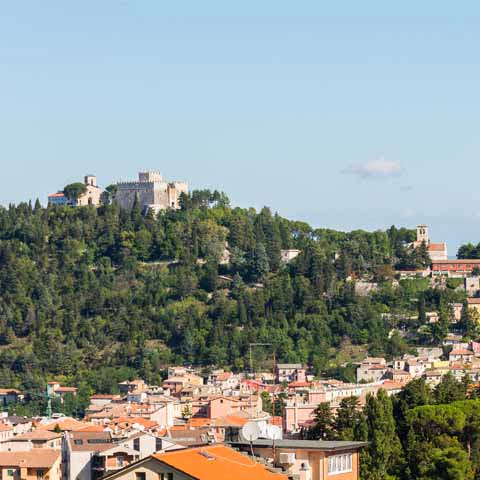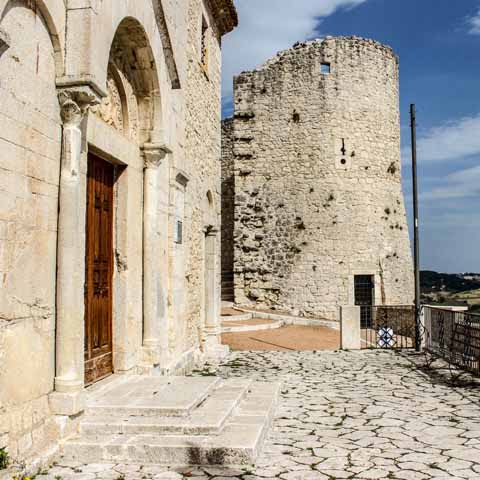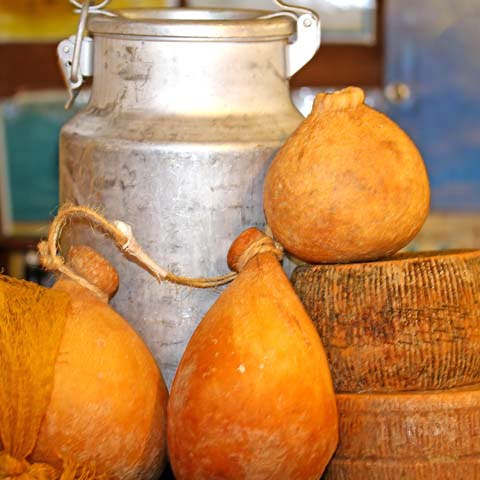The city of Campobasso has a complex history that continues to be visible both physically and culturally. Founded by the
Lombards, the early site of a Samnite settlement was once known for its defensive strength with the famous Castello Monforte at the center of this power. It remains a symbol of the original old town – “Campus Vassus”, which was abandoned for the lower valley plains – “Campus Bassus” in the early 1700s. Campobasso has since suffered its share of hardships leading to what visitors will find in the city today. From the destructive nineteenth century earthquakes to the conflict it experienced during World War II, there has been substantial building and rebuilding of the historic architecture.
Campobasso is the capital and largest city of the Molise region and located in the Campobasso province. Just about 3 hours southeast of Rome, this quaint city has a varying landscape from the mountain foothills to the valley below. It is easily accessed by car on the modern highway system – making exploring the city achievable for travelers visiting other locations throughout Italy.
Approximately 50,000 people call Campobasso home and the city gives the impression of a characteristic southern Italian town. It is known for its serene and natural environment, cooler climate, and absence of the crowds often found in popular tourist cities including Rome and Florence. Campobasso is often described as one of the country’s hidden gems – often overlooked, yet full of the same Italian ambiance visitors come to find. The city provides the chance to see Romanesque and medieval churches, archaeological, remains and quaint piazze.
Historically, the city of Campobasso was well known for its production of cutlery such as blades, knives, and scissors. While that industry has declined substantially, the city remains a hub for industrial production. Today, the locals are known for their production of soap, cement, and a variety of fine textiles. As with much of Italy, the city is famed for its local culinary products. Biferno wine, sausage, mushrooms, the prized truffle, and scamorza cheese are just a few of what visitors should try when in town.
A piece of the city’s culture lies in the higher education opportunity available at the University of Molise. Headquartered in Campobasso, the public college was created in 1982 with the goal of keeping all associated campuses within the Molise region. Over ten thousand students from all over Italy and beyond have been drawn to the university’s location and diverse offerings including Agricultural Science, Economics, Law, and Engineering. The Campobasso campus is home to the renowned Colozza Center – a particular draw for students, aimed at providing master’s degree level courses for future secondary education teachers.
GEOGRAPHY & CLIMATE
The city of Campobasso covers just over 21 square miles in Southern Italy. It is situated in the Biferno River’s high basin at approximately 2,300 feet above sea level. This capital city of Molise is encircled by the mountainous terrain of the Matese, Apennine, and Sannio ranges and the province is in the path of the Fortore, Biferno, and Trigno Rivers. The Adriatic Sea is just a short distance to the east of the centrally located city.
The city’s position in the valley between mountains greatly impacts the overall climate that visitors can expect. Its low elevation makes Campobasso relatively cool compared to other Southern Italian cities. It sees conditions that are a blend of oceanic and subtropical climates. The fall and winter seasons can be a bit chilly with frequent rain. While this time of year can bring in the most visitors, it is not uncommon to see numerous snow events in the colder winter months. The spring sees temperatures start to warm up, while the summer provides the most sun and ideal temperatures for exploring the city.
WHEN IN CAMPOBASSO
A must-see while in Campobasso is the majestic Castello Monforte, a fifteenth century castle set on a hill that is a focal point of the old city. The structure saw devastating damage during an earthquake in 1456 and was rebuilt over the Norman and Lombard ruins by feudal ruler Nicola Monforte II. Its quadrilateral walls provide the basis of its massive presence. Upon closer inspection, visitors can take in the four defensive towers and the merlons that line the top of the castle to provide additional protection against intruders. The main entrance shows evidence of a drawbridge while remnants of the Oscan-Samnite walls can be found on the inside. Visitors can explore the underground shelters and galleys, water storage areas, and even a modern-day Air Force meteorological station. It is imperative to catch the magnificent view of the surrounding valley, foothills, and mountains while at the top of the castle.
The Mazzarotta Palace is a sixteenth century palace located in the city’s center that was once home to the Neapolitan Mazzarotta noble family. The family’s coat of arms featuring a dolphin can still be seen. The palace is the current location of the Samnite Museum of Campobasso – run by the region’s Museum Complex. On exhibit are many ancient finds of the province of Campobasso dating from Prehistory to the Early Middle Ages. Visitors will find some of the first bronze weapons, ancient terracotta, jewels, and marble sculptures.
Travelers should also set aside time to visit the remains of the ancient village located underneath the city of Campobasso. These underground tunnels once allowed soldiers to move between defensive towers. The tunnels were also used as warehouses to store goods such as flour and salt and served as air raid shelters during World War II.
For a short excursion away from Campobasso, visitors should consider heading southeast to the city of Foggia in the region of Apulia. Similarly, Foggia is not a main tourist site – resulting in less congestion to enjoy all the city has to offer. It offers stunning architecture including the Cathedral of Foggia – built in a Baroque style complete with detailed stone work and a lavish organ. The main Piazza Umberto Giordano is a great location to peruse the shops and enjoy a bit of local cuisine. Visitors should also visit the nearby Parco Nazionale del Gargano – one of Italy’s largest natural parks.
Located off the typical traveler routes, Campobasso is an enchanting city found in the heart of Southern Italy. During a trip to Campobasso, visitors can admire the local art and architecture and unwind in the natural beauty of the Molise region.Travel Guides
The Molise Region of Italy
The Cities of Molise, Italy
Campbasso


